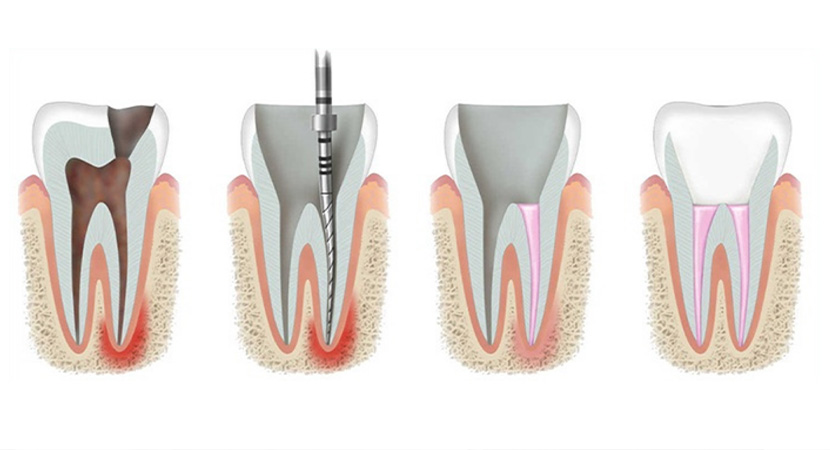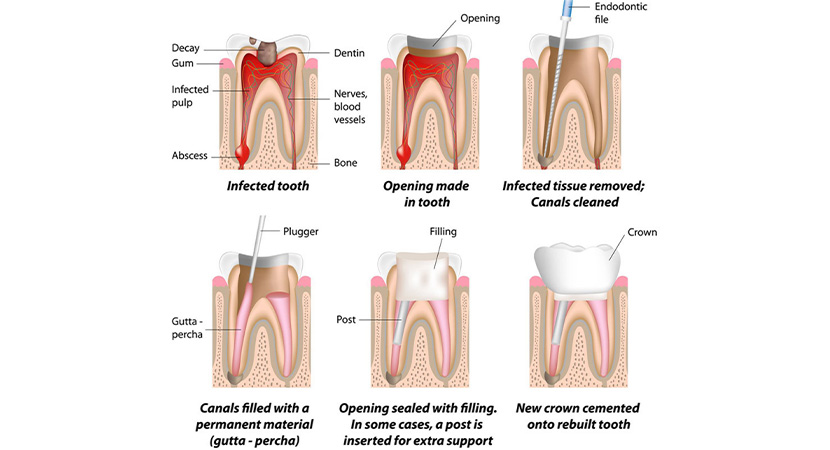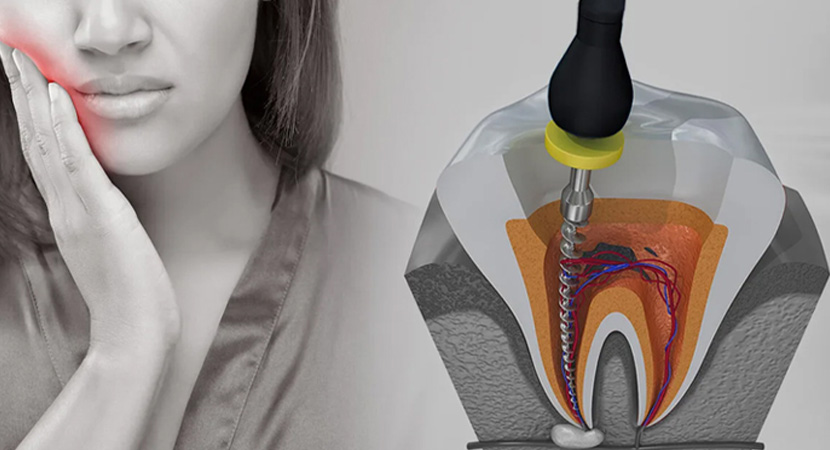
Root Canal Treatment
When it comes to dental services, the root canal procedure is often one of the scariest procedures among patients - but with an experienced specialist, root canals are no worse than any other procedure.
Although it may not be known as the most comfortable process, root canal treatment involves standard conservative procedures with a documented success rate of over 90%. Root canal therapy, also known as endodontic treatment, will allow the tooth to function normally while preserving its natural aesthetics, ultimately saving the tooth from extraction.
Key Facts
• Root canal treatment is a dental procedure that involves removing infected soft tissue (dental pulp) inside the tooth.
• It is also known as endodontic treatment.
• You may need more than one visit to your dentist or dental specialist (endodontist) for this treatment.
• Root canal treatment can save a tooth that would otherwise need to be extracted.

What is Root Canal Treatment?
Root canal treatment, also known as root canal therapy (RCT) or endodontic treatment, is a dental procedure that involves drilling into a decayed tooth to remove the soft center - the dental pulp.
This pulp consists of connective tissue, nerves, and blood vessels and extends into the root of the tooth - removing this soft center is crucial to prevent further decay.
Depending on the tooth, crown replacement may also be involved - this involves replacing the surface of the tooth used for chewing.

Do I need Root Canal Treatment?
In general, root canal treatment is warranted when the pulp of the tooth (and the blood vessels and nerves inside) is damaged or infected due to events such as tooth trauma, deep decay, cracks and chips, or repetitive dental procedures. If you're wondering whether you might need a root canal, there are a few things to consider. They will include the current condition of your teeth and whether there are severely decayed teeth.
Assessing the current condition of your teeth is an important step to take in managing oral health first and foremost.
Consider your dental history - this means thinking about how often you engage in dental care practices like brushing your teeth and even knowing whether you've had previous instances of infection or have a history of dental activity.
Then, if you're experiencing severe pain, this could be another indicator of damaged, dead, or infected teeth. If your tooth hurts when you apply pressure, it's important to get a professional opinion.
Ultimately, the best way to understand the current condition of your teeth is to visit your specialist for an examination.
Specifically, signs of pulp infection include discomfort and pain in and around the tooth and gums, sensitivity to hot or cold temperatures, and swelling of the gums or face. If you experience these symptoms, your dentist will likely recommend root canal treatment to remove the diseased pulp and clean and seal the root canal system.
Benefits of Root Canal Treatment
When it comes to the benefits of root canal treatment, they are numerous.
Firstly, it allows you to preserve your natural tooth - this in itself has a host of advantages, including the fact that it will always feel and function better than a denture or implant. It performs better in terms of chewing and will limit the likelihood of future dental expenses and procedures.
Secondly, root canal treatments are relatively painless with little discomfort - compared to other dental procedures, such as natural tooth extraction, the root canal procedure is often entirely painless. This is thanks to modern dental technology, local anesthesia that numbs the area, and the expertise of endodontists in a good specialized practice.
Additionally, the root canal procedure is quick and cost-effective - as explained below in the section on what happens during the root canal procedure, the root canal process is usually more effective than tooth extraction.
Risks of Untreated Tooth Infection
In addition to understanding the benefits of root canal treatment, it is also important to understand the risks that come from leaving an infected or damaged tooth untreated.
Firstly, a tooth abscess or infection of the root canal will almost certainly require treatment - root canal therapy in many cases is the best approach to eliminate a tooth abscess (when bacteria enter the pulp chamber and multiply).
If left untreated, a tooth abscess can lead to a range of problems, from severe pain, discomfort, and nerve damage to swelling, debris-filled swelling, facial swelling, and tooth discoloration.
Moreover, if left untreated, severe cases can have the infection spread to the root canal. It's also worth noting that an infected tooth can affect teeth that have had previous dental work. As a result, treatment is crucial if you have a tooth abscess or infection. There is a case where the infection may spread to the brain and lead to a fatal outcome.
Ultimately, if you need a root canal procedure, don't delay it. Starting treatment too late for infected teeth often requires tooth extraction. If left untreated, you risk encountering additional oral problems that could potentially last a lifetime.

What happens during a Root Canal Procedure?
Within procedures related to root canals, our dental medicine specialists undertake certain processes that involve broader tasks such as X-ray imaging and general consultation, as well as more specific stages in carrying out the treatment of root canals in a tooth.
First, your specialist will identify the problem, after which they will take an X-ray of the relevant tooth and the area surrounding it.
Following this X-ray process, when it comes to the procedure itself, the area of the tooth will be numbed with a local anesthetic. Additionally, your tooth may be covered with a rubber dam or sheet, which isolates the respective tooth from the rest.
As for the removal process, the dental practitioner will remove the diseased pulp from the inside and clean and seal the root canal system. The pulp chamber is accessible from the top of the tooth, and once cleaned, the root canals are filled with a natural latex material called gutta-percha.
Finally, the tooth will be sealed either with a filling or a crown. Often, a temporary filling is used to seal the cavity, which will be replaced with a permanent one once the root canal heals.
The treatment can be completed in one or two visits depending on the complexity of the case and is best undertaken by a qualified root canal specialist who is available to you here with us.
How can I avoid Root Canal Treatment?
When aiming to avoid root canal therapy, there are several things you can do.
Brush your teeth regularly - this means brushing your teeth twice a day and flossing every day.
Wear a mouthguard when necessary – if you engage in sports that may require it, or if you grind your teeth while sleeping, a mouthguard is a great way to protect your teeth.
Make sure you have regular check-ups and cleanings - this also means visiting your dentist as often as possible.
Avoid or limit hard foods in your diet - this may include candies and lollipops or even ice, which can cause cracks and fractures in your teeth and fillings.
Avoid or limit sweet and acidic foods and drinks - for example, soft drinks can erode your tooth enamel and attract bacteria.
Ultimately, preventing root canal treatment (and the problems that necessitate it) is the best way to save yourself pain, money, time, and medical issues. As a result, acquiring these habits and ensuring you take appropriate precautions is crucial for avoiding natural root canal treatment.
Regenerative Endodontic Procedures
Traditionally, when an immature tooth suffers root damage, we perform apexification to harden the root end and close the canal. Although effective, this also means that the tooth root will not continue to develop.
With regenerative endodontics, instead, we rejuvenate or regenerate the natural tissue of the tooth so that the root can continue to grow.
Regenerative endodontics employs the concept of tissue engineering to restore the canals to a healthy state. The advantages of this method include continued root development and strengthening of hard tissues to prevent potential fractures. While tissue regeneration procedures are still in the early stages, studies show that "dead," immature teeth are capable of regenerating pulp-like tissues that promote root development.
In a little over 10 years, regenerative endodontics has had a significant impact. This advancement in endodontic treatment means that the teeth of young patients aged 7 to 16 can be restored to continue growing, leading to the benefit of a natural tooth for a lifetime.
Endodontic Retreatment
There are cases where a tooth that has undergone root canal treatment may fail to heal, or the pain may persist. Failure can occur months or years after the initial treatment.
Reasons why treatment may fail:
• Curved or narrow canals that were not treated during the initial treatment.
• Complex canals that were not detected during the initial treatment.
• The crown or restoration was not placed within the appropriate timeframe after the procedure.
• A crown or restoration that does not seal well, allowing contamination of the tooth interior.
• New decay may expose the filling material, causing infection.
• A cracked or loose filling or crown may expose the tooth to new infection.
Retreatment Process
Once retreatment is chosen as a solution, your tooth will be reopened to access the root canal filling material. This filling material will be removed. Then your endodontist will clean your canals and carefully examine the inside of the problematic tooth. Once cleaned, the canals are filled and sealed, and a temporary filling is placed in the tooth.
At this point, you will need to return to your dentist as soon as possible to place a new crown or tooth restoration to restore its full functionality.
Assuming you have returned to your dentist on time, you should now have a healthy, pain-free tooth that will last you for many years to come, and since this is still your natural tooth, you will not need any additional maintenance on this tooth except to keep it clean.
Frequently asked questions about Root Canals
Is root canal treatment painful?
Root canals are treated with local anesthesia to numb the tooth and gums and are usually no more painful than getting a filling. Typically, the alternative could involve tooth extraction or enduring an infection, which is likely to cause discomfort.
Root Canal vs. Filling: What's the difference?
Fillings are recommended when the tooth has a small cavity or decay has not yet reached the pulp chamber—on the other hand, root canal treatment may be necessary if decay has reached the dental pulp and caused an infection.
How long does a root canal treatment take?
Approximately 95% of root canal treatments are successful—afterward, the affected tooth can continue to exist with proper care for a lifetime. Depending on the case, your dentist may recommend a crown or a filling to maximize the tooth's lifespan. Improper care or a defective root canal could mean bacteria re-entering the tooth, requiring additional treatment.
Is sedation necessary for root canal treatment?
Sedation is not necessary for root canal treatment—instead, dentists will use local anesthesia. Patients with special needs may also receive nitrous oxide sedation to help them relax.
How long does root canal treatment take?
On average, a root canal procedure will take somewhere between 30 to 60 minutes. In more complex situations, procedures may take up to 90 minutes or may be performed over two visits.
Do I need a crown after a root canal?
After a root canal, the crown will strengthen the outer part of the tooth and restore its functionality. While not all treatments will require reinforcement to the same extent, some form of support is usually necessary—whether it's a crown or a filling.
How long does it take to recover from a root canal?
While the recovery time varies, mild pain after a successful root canal surgery can last up to three days. Taking a day off is recommended, but in most cases, patients can return to their normal routine the next day, provided they practice good oral hygiene.
What are common signs and symptoms that a tooth may need root canal treatment?
Although many cases may proceed without symptoms, some indications for treatment may include prolonged temperature sensitivity, spontaneous pain, tooth discoloration, sensitivity of the tooth or surrounding gum tissue, and swelling.
How can endodontic treatment help me?
The goal of endodontic treatment is to remove bacteria causing inflammation or infection and help you retain your natural tooth. With modern techniques, most of our root canal therapies can be completed in a single visit. After treatment, long-term restoration may be recommended to guard against reinfection by your general dentist.
Will I feel pain during or after the treatment?
Thanks to modern anesthetics, most procedures are painless. We'll take all necessary steps to manage post-procedural discomfort, which may include the use of anti-inflammatory drugs and antibiotics.
Do I need to come back for check-ups after the treatment?
To ensure you're receiving the best available care, we always recommend follow-up visits to ensure the treatment was successful. Typical follow-up times are 6 months to 1 year, but may vary depending on the type of treatment.
Can I drive or return to work after my procedure?
Most of the time, the same local anesthesia is used as if you were undergoing general dental work, like fillings. The anesthesia usually lasts 1 to 3 hours but shouldn't affect your overall cognitive abilities. Procedures involve prolonged healing times and may require rest for the remainder of the day. Every case is different, and post-operative care will be thoroughly explained on the day of treatment.


